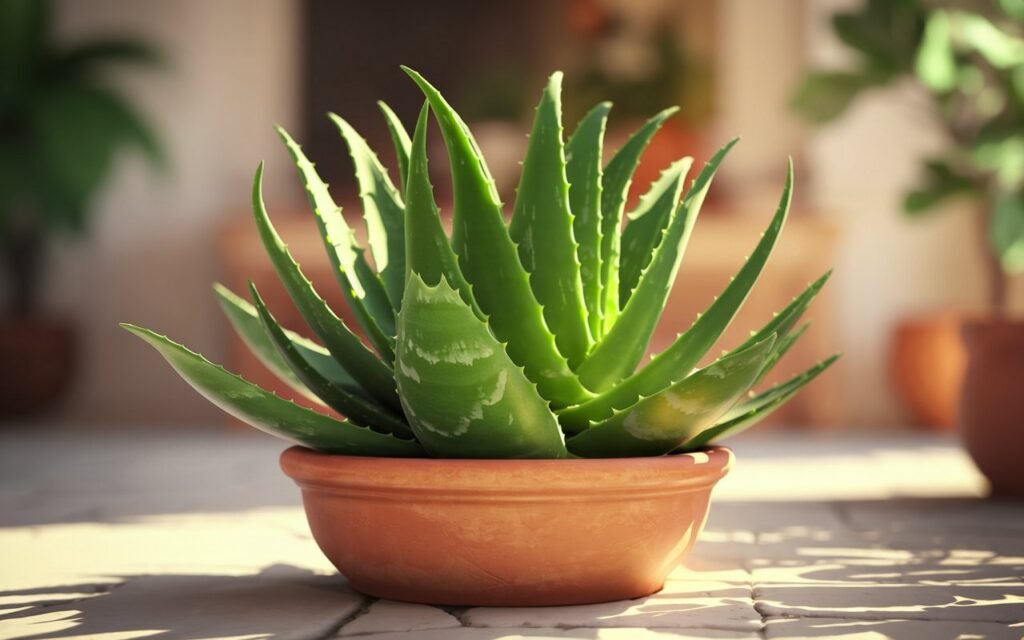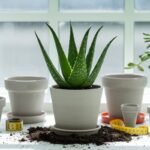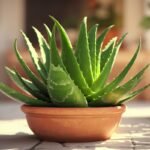How do you encourage aloe vera to grow?
Aloe loves bright light. A sunny spot is ideal. Water thoroughly when the soil is dry to the touch. Don’t overwater; soggy soil can cause root rot. Well-draining soil is a must; add some perlite or sand to your potting mix. Keep it warm. Aloe prefers temperatures between 55 and 80 degrees Fahrenheit. Feed it occasionally during the growing season (spring and summer) with a balanced liquid fertilizer.
Aloe Vera Growth: Getting Started
So, you want to know about aloe vera growth tips? It’s simpler than you might think. Having a thriving aloe plant really comes down to understanding its basic needs. We’ll walk you through everything, from picking the right pot to dealing with potential issues. Whether you’re just starting with aloe vera plant care or wondering how to improve your plant’s growth, this guide will help. Let’s look at how to get your aloe vera growing happily.
First things first, aloe vera likes it snug. Don’t pick a huge pot right away. Choose one just a little larger than the root ball. Terracotta is a good choice because it allows for good drainage and airflow, which helps prevent aloe vera root rot. Speaking of drainage, make sure the pot has a drainage hole. Aloe definitely doesn’t like sitting in water. This is a key step in aloe vera repotting, too.
Next up is the soil. Regular potting soil won’t cut it. Aloe vera needs a well-draining mix. You can buy a cactus and succulent mix or make your own using regular potting soil, perlite, and coarse sand. This helps prevent problems with overwatering, which can lead to issues like aloe vera leaves turning brown. Getting the soil right helps you learn how to make aloe vera grow faster, because healthy roots mean healthy growth.
Once you’ve got the pot and soil sorted, you can plant your aloe. Gently remove the plant from its current container, loosen the roots a bit, and place it in the new pot. Fill the space around the roots with your soil mix, gently firming it down. Don’t water right away after planting. Give those roots a few days to adjust.
Perfect Potting Mix for Aloe Plants
Getting the right soil is key for happy aloe. These plants don’t like to sit in wet dirt, so good drainage is essential. A regular potting mix just won’t cut it. It holds too much water and can lead to aloe vera root rot. What you want is a mix that lets water pass through easily. Think of a desert – dry and airy.
You can buy a special cactus and succulent mix, or make your own. A simple recipe is to combine regular potting soil with perlite and coarse sand. The perlite creates air pockets, and the sand helps with drainage. Aim for a ratio of about one-third potting soil, one-third perlite, and one-third sand. This will create the perfect environment for your aloe vera plant care and help achieve a healthy aloe vera growth rate.
When you pot your aloe, choose a container with drainage holes. Terra cotta pots are great because they’re porous and allow extra airflow. This can help prevent overwatering and ensure your aloe gets the right balance of moisture and air. Choosing the best pot for aloe vera is an important part of ensuring healthy growth.
With the right soil and pot, your aloe will be well on its way to thriving! This setup encourages strong roots and sets the stage for vigorous aloe vera growth. If you’re aiming to make aloe vera grow faster, the right potting mix is a great first step.
Watering Aloe Vera for Optimal Growth
Watering your aloe vera correctly is key for healthy growth. Think “”less is more”” with these desert-loving plants. Overwatering is a common problem, leading to aloe vera root rot, so it’s best to err on the side of dryness.
How can you tell when your aloe needs a drink? Check the soil. Let it dry out completely between waterings. Stick your finger about two inches deep into the pot. If it’s dry, it’s time to water.
When you do water, water deeply. Soak the soil until water drains out of the drainage holes. This ensures the roots get a good drink. Then, let the pot drain completely. Don’t let your aloe sit in standing water. This can cause the roots to rot.
How often you water depends on a few things like the size of the pot, the aloe vera plant care you follow, the time of year, and your climate. During hotter months or if your aloe is in a sunny spot, it will likely need water more often. In the winter, you can cut back significantly. Proper aloe vera winter care involves less frequent watering. Remember, observing your plant and its soil is the best way to figure out its specific needs.
Adjust watering aloe vera schedules according to the season. You’ll water less often during cooler months and more frequently during warm, dry periods. This mimics the plant’s natural environment and supports healthy aloe vera growth rate.
If you notice the aloe vera leaves turning brown, it could be a sign of overwatering or underwatering. Check the soil moisture and adjust your watering accordingly. Learning to read your plant’s signals will help you provide the best aloe vera care indoors.
Sunlight Needs: How Much Sun for Happy Aloe?
Aloe vera plants love light. Think bright, indirect sunlight. A sunny windowsill is often perfect. Six to eight hours of this type of light each day will keep your aloe happy.
Too much direct sunlight can be a problem. It can scorch the leaves. You’ll see them turn brown or reddish. If this happens, move your plant to a spot with a bit more shade. A sheer curtain can filter the light nicely.
Not enough light can also cause issues. Aloe vera growth rate can slow down. The plant may become weak and leggy, stretching towards the light source. If your aloe isn’t getting enough natural light, consider a grow light. This can supplement the available light and encourage healthy aloe vera plant care.
Pay attention to your plant’s leaves. They’ll tell you if the lighting is right. Healthy aloe leaves are plump and green. Adjust the light as needed for optimal aloe vera growth tips. Watch it flourish! This attention to light is key for your aloe vera care indoors routine.
Feeding Your Aloe: Fertilizer Tips
Thinking about giving your aloe vera plant a little boost? A bit of food can help, but aloe vera isn’t a heavy feeder. Too much can harm its roots. So, less is more!
A balanced, water-soluble fertilizer, diluted to half strength, is perfect. Look for something formulated for succulents or cacti. These often have the right mix of nutrients to encourage healthy aloe vera growth.
When should you feed it? During the growing season, which is typically spring and summer. Once a month is plenty. Hold off on feeding during the fall and winter months, as the plant’s aloe vera growth rate slows down. It’s resting then and doesn’t need the extra nutrients.
If you’re not sure about using fertilizer, you can also try enriching the soil with compost. This provides a slow release of nutrients and improves drainage – something aloe vera loves. Just remember, healthy aloe vera soil is key for good growth.
Over-fertilizing can lead to salt buildup in the soil, which can damage the roots and affect water absorption. Signs of this include brown leaf tips and stunted growth. If you suspect you’ve overdone it, flush the soil with plenty of water to help leach out excess salts. You can even consider aloe vera repotting if the issue persists.
Repotting Aloe Vera: Signs and Steps
Sometimes, your aloe vera needs a new home. Look for roots circling the bottom drainage holes or pushing the plant upwards. This shows it’s root-bound. A crowded pot slows aloe vera growth rate. Pick a pot a little bit bigger than the old one – terracotta is great, as it helps the aloe vera soil dry out between waterings, reducing the risk of aloe vera root rot.
Aloe vera repotting is simple. Gently remove the plant from its old pot. Tease apart any tangled roots. Put a layer of fresh potting mix in the new pot. Place the aloe in the center, making sure the top of the root ball is just below the pot’s rim. Fill in the gaps with more mix, firming it lightly. Don’t water immediately after repotting. Wait a few days to give the roots time to adjust and reduce the chance of overwatering. This helps to achieve aloe vera growth tips.
If you spot small plants, called aloe vera pups or aloe vera offshoots, growing at the base of the mother plant, you can separate and plant them individually. This is a great way of aloe vera propagation, giving you even more aloe plants to enjoy! With the right pot and some gentle care, you’ll see positive changes in your aloe vera plant care and your plant will appreciate the extra space to grow. This addresses how to make aloe vera grow faster.
Troubleshooting Aloe Vera Growth Issues
Sometimes, despite our best efforts, aloe vera plants can experience problems. Let’s look at some common issues and how to address them.
Aloe vera leaves turning brown can indicate several things. Overwatering is a frequent culprit. Check the soil; if it’s soggy, let it dry out completely before watering again. Too much direct sunlight can also cause browning. Move your plant to a spot with some shade, especially during the hottest part of the day. Another possibility is nutrient deficiency. Consider adding a balanced aloe vera fertilizer.
Aloe vera root rot is a serious problem often caused by overwatering and poor drainage. If you suspect root rot, gently remove the plant from its pot and check the roots. Healthy roots are firm and white; rotting roots are mushy and brown or black. If you find rot, trim away the affected roots with a clean knife. Repot your aloe in fresh, well-draining aloe vera soil, ensuring the best pot for aloe vera has drainage holes. Adjust your watering aloe vera habits to prevent future issues.
If your aloe vera growth rate seems slow, consider its environment. Is it getting enough aloe vera sunlight needs? During winter, growth naturally slows, so don’t be alarmed if you see less activity. Adjust your aloe vera winter care or aloe vera summer care accordingly.
If you’re unsure about your aloe vera plant care, remember there are many resources available to help. Learning about aloe vera propagation, aloe vera repotting, and how to make aloe vera grow faster can make all the difference in the health of your plant.
Common Aloe Vera Pests and How to Control Them
Sometimes, little critters can bother your aloe. Mealybugs look like tiny bits of cotton and hide in the leaves. If you spot them, dab them with a cotton swab dipped in rubbing alcohol. Another pest is scale, which appears as small, brown bumps. You can gently scrape them off with your fingernail. Spider mites are super tiny and make fine webs. A good spray of water can often dislodge them.
For a bigger infestation, you might try insecticidal soap. Always test it on a small area first to make sure it doesn’t harm your aloe vera plant. Keeping your plant healthy is the best defense! A strong aloe vera plant is less likely to attract aloe vera pests in the first place. So, make sure you’re giving your plant the right aloe vera plant care, including proper watering aloe vera and enough aloe vera sunlight needs. This helps prevent aloe vera diseases too.
If you’re unsure about what’s bugging your aloe, take a picture and show it to your local garden center. They can help you identify the aloe vera pests and recommend the best way to handle them. This also helps avoid issues like aloe vera leaves turning brown which can be a sign of pests or other problems.
Propagating Aloe Vera: Growing New Plants
Want more aloe? It’s easy! Aloe vera makes baby plants, called aloe vera pups or aloe vera offshoots. These sprout up around the base of the mother plant. When they’re a few inches tall, it’s time to give them their own home. Gently remove the pup, making sure it has its roots. Let the pup sit out for a day or two so the cut part dries. This helps prevent aloe vera root rot. Then, plant it in a small pot with soil specifically made for succulents or cacti – this is the best pot for aloe vera pups. Water lightly and place it where it gets bright, indirect light.
You can also try growing aloe from a leaf, although this is less reliable. Cut a healthy leaf from the base and let it dry for a few days, just like with the pups. Plant the cut end in the same type of soil and wait. It might take a while, but with proper aloe vera plant care, you might see a new plant grow from the aloe vera propagation from leaf. Keep the soil lightly moist and be patient – new growth is a sign of success.
This is a simple way to increase your aloe vera collection. With a little aloe vera propagation know-how, you’ll soon have plenty of plants to enjoy and share! This will also help with how to make aloe vera grow faster overall by allowing the mother plant to focus its energy. Remember, proper aloe vera care indoors is essential for successful propagation.
Keeping Your Aloe Thriving Long-Term
You’ve nurtured your aloe, watched it grow, maybe even propagated a few aloe vera pups or aloe vera offshoots. Now, how do you ensure its continued success? A healthy aloe is a happy aloe. Regular checks are key. Look at the leaves. Are they plump and green? Or are they aloe vera leaves turning brown? Brown leaves can signal a few things, from too much sun to not enough water. Feel the soil. Is it bone dry or still a little damp? This will guide your watering aloe vera schedule.
Remember, aloe vera root rot is a common issue from overwatering, so err on the side of dryness. During the growing season, think spring and summer, consider some aloe vera fertilizer. But be gentle! Too much can be harmful. Winter is a time for rest. Cut back on watering and hold off on feeding. Think of it as the plant’s dormant period. As your aloe grows, it might need a new home. Aloe vera repotting isn’t frequent, but knowing the signs, like roots circling the pot, is part of aloe vera plant care. Choosing the best pot for aloe vera is important too – terracotta is a good choice as it allows the soil to breathe.
By following these tips and paying attention to your plant’s individual needs, you can enjoy a thriving aloe vera for years to come. Adjust your aloe vera winter care and aloe vera summer care accordingly. Even try aloe vera propagation from leaf for more plants! Learn more about aloe vera growth rate and how to make aloe vera grow faster with proper care.






